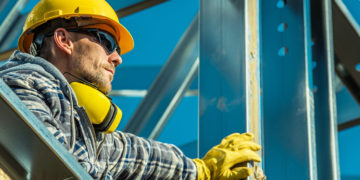Stop Work Authority – A New York Guide

What is Stop Work Authority?
Stop Work Authority (SWA) is a program structured to help prevent accidents from occurring on the job by creating a “safety first” culture. Its design encourages employees and contract workers to step forward and halt working on a job if an unsafe condition is perceived to be present. It is a multi-step process:
- Stop
- Notify
- Investigate
- Correct
- Resume
- Follow-up
Following these steps sequentially ensures SWA events work as they are designed to do. Missing a step or doing them out of order significantly reduces the effectiveness of this program.
Construction Accidents in New York City
New York City officials have recently put additional legal protections in place, but considering in the first half of 2019, there have already been 287 injuries and five fatalities at construction sites across all five boroughs, this shows more needs to be done because if the rate of accidents continue for the rest of the year, it will surpass 2018’s high injury and fatality rates.
No family should have to experience the pain and suffering associated with construction accidents, especially when there are ways to ensure the recognized hazards found on job sites can be better eliminated. If all employers were to initiate SWA voluntary protection programs, this can help to reduce these tragedies. This is not to say SWA programs should be the first line of defense or the main idea behind a company’s safety program, but SWAs are a good way to empower workers to protect themselves and others in times they need it.
SWA Roles and Responsibilities
Compliance with SWA ensures every precaution has been taken to protect workers, visitors, and passerby on construction sites. Many employers encourage SWA to be used at job sites because it can help prevent injuries and fatalities. These companies will stop work and resume work in the work area only after working conditions are deemed to be safe. If an SWA program is going to succeed, it needs all company employees to buy-in to the program. This includes everyone from upper management and ownership down to the worker physically on the job site. Roles for each person should be clearly defined.
- Upper management: This role takes on the task of nurturing a culture of SWA and providing clear expectations, responsibilities, and accountability for anyone involved in the work. This includes any contractors or subcontractors working with the company. The responsibility of senior management also includes reassuring people they won’t be penalized or harmed for speaking up.
- Managers and supervisors: Their roles continue in the same vein as upper management with promoting an SWA-based safety culture but in a more hands-on role. These employees can also serve as safety managers to ensure SWA requests are accepted and completely resolved before resuming work.
- Employees and contractors: Take steps to initiate stop-work authority if they deem it warranted and support their coworkers’ initiatives as well.
“If a company has an HSE (Health, Safety, and Environment) Department, they’ll provide everyone associated with the organization training, support and documentation supporting SWA and its compliance requirements. If not, other managerial personnel should provide this information.”
Brian O’Dwyer, Construction Accident Lawyer – O’Dwyer & Bernstien
What Are Stop Work Authority Obstacles Employees Face?
Unfortunately, some NYC construction companies or general contractors are less focused on stabilizing a situation than they are of cutting corners. Regrettably, companies and contractors in New York City are notorious for committing building violations. Workers may need to initiate a stop-work request if they see current or imminent danger. This could occur due to situations including alarms, emergency situations, improperly used equipment, hazardous conditions, near-miss incidents, or a lack of information, understanding, and knowledge. Additionally, a change in conditions, work scope, or work plan could also warrant an SWA.
“Employees face several obstacles when it comes to deciding if their stop-work complaint is valid, and these may hold them back from speaking their concerns. This is especially true for those who work for employers who readily commit violations.”
Here are some reasons why workers are hesitant to make a move to keep a job site safe:
- Bystander effect: The bystander effect is a common occurrence in cases of emergencies when people tend to stay back and watch, waiting for someone else to take action. This phenomenon can also easily apply to dangerous work conditions on a construction site.
- Peer pressure: If other workers are willing to turn a blind eye to a building violation or other event, other workers may fall into line and accept their mindset in fear of going against the crowd.
- Pluralistic ignorance: A pluralistic ignorance barrier occurs when workers believe events, conditions, or opinions are a perceived norm, so they stay quiet about their concerns. Realistically, everyone else could be quietly carrying the same concerns.
- Diffusion of responsibility: This occurs when a worker prefers or refuses to take responsibility when other workers are around to do it.
- Fear of repercussions: Workers may worry they’ll lose their jobs or be penalized if they pursue a way to suspend work.
Additionally, many workers assume they don’t have any authority to play a role in the stop-work authority process or presume their coworkers know more about the situation than they do and trust they’d handle it if something was wrong. For SWA programs to work as designed, ownership and managers all need to encourage SWA requests when warranted and reassure employees that it’s OK to speak up.
New York City’s Stop Work Order Rules
Stop work authoring programs allow employees to proactively keep sites safe for themselves and their coworkers, especially when those tasked with keeping them safe don’t appropriately do their jobs. It also is a good way to let employers, who may not be anywhere close to the job site, know of the potential safety problems existing at their construction sites, giving them an opportunity to fix them.
“While SWA shouldn’t be the first line of defense, in some cases it needs to be to prevent a construction-related injury or death.”
Brian O’Dwyer, Construction Accident Lawyer – O’Dwyer & Bernstien
The New York City Buildings Department inspectors actively seek violations and are tasked with issuing Stop Work Orders (SWO) if they see work at a site is being done in an unsafe manner. Inspectors are given a broad range of authority under the city’s administrative code.
- Full Stop Work Order: Inspectors are allowed to prohibit all work, excluding remedial work necessary to secure the site’s safety.
- Partial Stop Work Order: Not all work on a job site is ceased, but certain areas or types of work may be halted.
- Enforce any work orders: NYC has laws in place to permit the issuance of penalties to anyone violating a full or partial stop-work order.
Once cited violations are corrected and verified, NYC inspectors will lift a stop-work order and allow the site to continue routine operations. A Certificate of Correction is necessary to certify the violation or summons has been rectified.
Construction Accident Lawyer – Here When You Need Us!
If you, or a loved one, have experienced the pain and suffering associated with a construction accident that could have been prevented, a construction accident lawyer can help. For over 100 years, the law firm of O’Dwyer & Bernstien has been a committed advocate for personal injury victims throughout New York. To learn more or to obtain a free consultation contact us today or call 212-571-7100.
Sources:
https://www.quora.com/What-is-HSE-1
https://www1.nyc.gov/assets/buildings/apps/pdf_viewer/viewer.html?file=2014CC_AC_Chapter2_Enforcement.pdf§ion=conscode_2014
https://www.shrm.org/resourcesandtools/hr-topics/risk-management/pages/stopping-unsafe-work.aspx
https://blog.wisebusinessware.com/safetyinsiderblog/how-to-establish-an-effective-stop-work-authority-program
https://www.safetyandhealthmagazine.com/articles/17242-stop-work-authority
https://www.onsitesafety.com/safety-articles/5-steps-to-a-safer-stop-work-authority-program/



